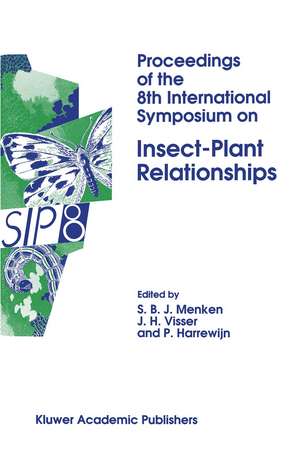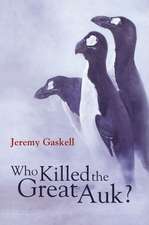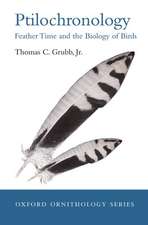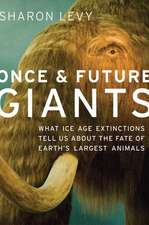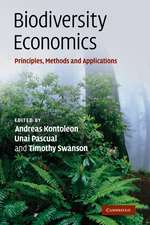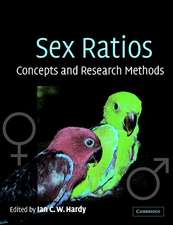Proceedings of the 8th International Symposium on Insect-Plant Relationships: Series Entomologica, cartea 49
Editat de Steph B. J. Menken, J. H. Visser, Paul Harrewijnen Limba Engleză Paperback – 29 oct 2012
The field of insect-plant interactions nowadays includes almost all of biology, as well as parts of chemistry and physics. It takes a central position in biology because insects are the most abundant animal group, half of them are herbivores and they dominate all terrestrial ecosystems. Knowledge of insect-plant interactions is thus fundamental to an understanding of the evolution of life on Earth.
Two major topics of worldwide concern give this field an extra dimension. First, large amounts of food crops are still lost due to insect pests. With the increasing concern for environmental pollution and the subsequent plans to drastically reduce pesticides, integrated pest management and development of resistant crops become a major focus in agriculture. The importance of the study of insect-plant relationships is thus continuously augmented. Clearly, successful pest control demands sufficient fundamental knowledge of pest-host interactions. Second, such work can contribute towards stopping or even counterbalancing the threatening biodiversity crisis thanks to an understanding of how the interaction of insects and plants has influenced and still influences the diversification and speciation (evolution) of both groups. These problems should, of course, be approached at a multitrophic level.
| Toate formatele și edițiile | Preț | Express |
|---|---|---|
| Paperback (1) | 396.40 lei 43-57 zile | |
| SPRINGER NETHERLANDS – 29 oct 2012 | 396.40 lei 43-57 zile | |
| Hardback (1) | 591.75 lei 43-57 zile | |
| Springer-Verlag GmbH – 30 noi 1992 | 591.75 lei 43-57 zile |
Din seria Series Entomologica
-
 Preț: 393.90 lei
Preț: 393.90 lei -
 Preț: 385.25 lei
Preț: 385.25 lei -
 Preț: 414.42 lei
Preț: 414.42 lei -
 Preț: 393.90 lei
Preț: 393.90 lei - 18%
 Preț: 830.70 lei
Preț: 830.70 lei - 18%
 Preț: 1220.75 lei
Preț: 1220.75 lei - 18%
 Preț: 1841.32 lei
Preț: 1841.32 lei - 18%
 Preț: 1218.04 lei
Preț: 1218.04 lei - 18%
 Preț: 1223.25 lei
Preț: 1223.25 lei -
 Preț: 385.62 lei
Preț: 385.62 lei - 24%
 Preț: 811.86 lei
Preț: 811.86 lei -
 Preț: 351.51 lei
Preț: 351.51 lei - 18%
 Preț: 810.99 lei
Preț: 810.99 lei -
 Preț: 403.53 lei
Preț: 403.53 lei - 18%
 Preț: 936.93 lei
Preț: 936.93 lei - 15%
 Preț: 642.83 lei
Preț: 642.83 lei -
 Preț: 393.59 lei
Preț: 393.59 lei - 18%
 Preț: 1664.26 lei
Preț: 1664.26 lei - 18%
 Preț: 1217.27 lei
Preț: 1217.27 lei - 18%
 Preț: 1386.30 lei
Preț: 1386.30 lei - 18%
 Preț: 1831.27 lei
Preț: 1831.27 lei - 18%
 Preț: 951.14 lei
Preț: 951.14 lei - 18%
 Preț: 2107.18 lei
Preț: 2107.18 lei - 18%
 Preț: 1219.77 lei
Preț: 1219.77 lei - 18%
 Preț: 1832.22 lei
Preț: 1832.22 lei - 18%
 Preț: 1229.91 lei
Preț: 1229.91 lei - 18%
 Preț: 1594.64 lei
Preț: 1594.64 lei - 18%
 Preț: 1833.16 lei
Preț: 1833.16 lei - 18%
 Preț: 1392.95 lei
Preț: 1392.95 lei - 18%
 Preț: 1237.93 lei
Preț: 1237.93 lei - 18%
 Preț: 1219.31 lei
Preț: 1219.31 lei - 24%
 Preț: 1073.70 lei
Preț: 1073.70 lei -
 Preț: 389.70 lei
Preț: 389.70 lei - 18%
 Preț: 1246.15 lei
Preț: 1246.15 lei - 18%
 Preț: 1226.70 lei
Preț: 1226.70 lei - 18%
 Preț: 1225.31 lei
Preț: 1225.31 lei - 18%
 Preț: 1232.89 lei
Preț: 1232.89 lei - 18%
 Preț: 1832.22 lei
Preț: 1832.22 lei - 18%
 Preț: 1232.71 lei
Preț: 1232.71 lei - 24%
 Preț: 1604.87 lei
Preț: 1604.87 lei
Preț: 396.40 lei
Nou
Puncte Express: 595
Preț estimativ în valută:
75.85€ • 79.40$ • 63.13£
75.85€ • 79.40$ • 63.13£
Carte tipărită la comandă
Livrare economică 31 martie-14 aprilie
Preluare comenzi: 021 569.72.76
Specificații
ISBN-13: 9789401047234
ISBN-10: 9401047235
Pagini: 440
Ilustrații: XII, 424 p.
Dimensiuni: 160 x 240 x 23 mm
Greutate: 0.61 kg
Ediția:1992
Editura: SPRINGER NETHERLANDS
Colecția Springer
Seria Series Entomologica
Locul publicării:Dordrecht, Netherlands
ISBN-10: 9401047235
Pagini: 440
Ilustrații: XII, 424 p.
Dimensiuni: 160 x 240 x 23 mm
Greutate: 0.61 kg
Ediția:1992
Editura: SPRINGER NETHERLANDS
Colecția Springer
Seria Series Entomologica
Locul publicării:Dordrecht, Netherlands
Public țintă
ResearchCuprins
The importance of herbivore population density in multitrophic interactions in natural and agricultural ecosystems.- The evolution of plant resistance and correlated characters.- Habitat impact on insect communities of annual and perennial grasses.- Predispersal seed predation in the limitation of native thistle.- Preference, tree resistance, or chance: how to interpret differences in gall density among trees?.- Aggregation of aphid galls at ‘preferred’ sites within trees: do colonizers have a choice?.- Abundance and mortality of a specialist leaf miner in response to shading and fertilization of American holly.- Within-population variation in demography of a herbivorous lady beetle.- Continental-scale host plant use by a specialist insect herbivore: milkweeds, cardenolides and the monarch butterfly.- Resource partitioning of host plants by insects on a geographic scale.- Why do droughts often result in devastating insect epidemics? The African armyworm, Spodoptera exempta, as an example.- The impact of water and nutrient stress on oak leaf quality and gypsy moth performance.- Forest insect trends along an acidic deposition gradient in the central United States.- Birch foliage quality and population density of Eriocrania miners in a pollution-affected area.- Performance of Neodiprion sertifer on defoliated scots pine foliage.- Comparative studies of developmental biology, preference and feeding behavior of Monellia caryella on Juglandaceae native to North America.- Host-plant selection by the tropical butterfly Bicyclus anynana.- Interactions between host-plant information and climatic factors on diapause termination of two species of Bruchidae.- Assessing host-plant suitability in caterpillars: is the weight worth the wait?.- Size, feeding ecology and feedingbehaviour of newly hatched caterpillars.- Natural defence of pedunculate oak (Quercus robur) against the defoliating insect Euproctis chrysorrhoea.- Estimating costs and benefits of the pyrrolizidine alkaloids of Senecio jacobaea under natural conditions.- Induced chemical defence in Cynoglossum officinale.- Conversion of plant-derived pyrrolizidine alkaloids into insect alkaloids.- Phytoecdysteroids and insect-plant relationships in the Chenopodiaceae.- The non-nutrional relationship of Zonocerus (Orthoptera) to Chromolaena (Asteraceae).- Search behaviour: strategies and outcomes.- Response of the oilseed rape pests, Ceutorhynchus assimilis and Psylliodes chrysocephala, to a mixture of isothiocyanates.- Volatile plant metabolites involved in host-plant recognition by the cabbage seed weevil, Ceutorhynchus assimilis.- The olfactory and behavioural response of seed weevils, Ceutorhynchus assimilis, to oilseed rape volatiles.- Dispersive flight of the cabbage stem weevil.- Responses of the black bean aphid, Aphis fabae, to a non-host plant volatile in laboratory and field.- Aggregation in a flower bud-feeding weevil.- Electroantennogram responses of aphids to plant volatiles and alarm pheromone.- The role of host-plant odour and sex pheromones in mate recognition in the aphid Cryptomyzus.- Comparison of electroantennogram responses by females of the black swallowtail butterfly, Papilio polyxenes, to volatiles from two host-plant species.- Olfactory and visual cues in host-finding in the Burnet moth, Zygaena trifolii.- Specialization of receptor neurons to host odours in the pine weevil, Hylobius abietis.- Plant chemicals involved in honeybee-rapeseed relationships: behavioural, electrophysiological and chemical studies.- Volatiles from soybean foliage detected by means of a TCT-HRGC system: their possible role in insect-plant relationships.- Host-finding by Phoracantha semipunctata: host volatiles, electroantennogram recordings and baited field traps.- Chemical recognition of diverse hosts by Pieris rapae butterflies.- Role of nutrients found in the phylloplane, in the insect host-plant selection for oviposition.- Oviposition stimulant for the cabbage root fly: important new cabbage leaf surface compound and specific tarsal receptors.- Tarsal contact chemoreceptors of the cherry fruit fly, Rhagoletis cerasi: specificity, correlation with oviposition behaviour, and response to the synthetic pheromone.- Dietary mixing in generalist grasshoppers.- Semiochemicals isolated from the eggs of Ostrinia nubilalis as oviposition deterrent in three other moth species of different families.- Roles of chemosensory organs in food discrimination by larvae of the tobacco hornworm, Manduca sexta.- Sensory responses to the triterpenoid antifeedant toosendanin.- Insect antifeeding activity of some cardenolides, coumarins and 3-nitropropionates of glucose from Coronilla varia.- Seasonal variation in the importance of pollen volatiles on the reproductive biology of the sunflower moth.- Seasonal variation in plant chemistry and its effect on the feeding behaviour of phytophagous insects.- Associative learning in host-finding by female Pieris brassicae butterflies: relearning preferences.- Circadian stability of olfaction in Lobesia botrana.- Whitefly preference-performance relationships.- The role of salts in the feeding behaviour of locusts.- Computer-aided analysis of chemosensory data.- Analysis of sensory information using neural networks.- Azadirachtin treatment and host-plant selection.- The effects of azadirachtin on feeding by Myzus persicae.- Effects of the plant-derived antifeedant polygodial on aphid host selection behaviour.- The geometry of feeding: a new way of looking at insect nutrition.- A common chemical mechanism for insect-plant communication.- Genetics and the phylogeny of insect-plant interactions.- Host-race formation in a leaf-mining moth.- Host-race formation in the two-spotted spider mite (Tetranychus urticae).- Variation in the suitability of Barbarea vulgaris (Cruciferae) for the flea beetle Phyllotreta nemorum.- Plant secondary chemistry and the evolution of feeding specialization in insect herbivores: a different perspective.- Population genetical evidence for host-race formation in Yponomeuta padellus.- Latitudinal trends in oviposition preferences: ecological and genetic influences.- Role of any single herbivore species in the evolution of willows.- Potential of plant-derived genes in the genetic manipulation of crops for insect resistance.- The development of host-plant resistance to insect pests: outlook for the tropics.- Endogenous proteinase inhibitors induced in tobacco in response to herbivory: effects on the interpretation of insect resistance of transgenic tobacco plants.- Effect of induced resistance mechanisms in potato and tomato plants on the Colorado potato beetle.- Influence of phenolic compounds on the relationship between the cassava mealybug and its host plants.- Measurements of host plant-resistance in Chrysanthemum to Frankliniella occidentalis.- An automatic and accurate evaluation of thrips-damage. Image-Analysis: a new tool in breeding for resistance.- Susceptibility of Chrysanthemum cultivars to thrips (Frankliniella occidentalis) infestation and the role of some physical plant characters.- Effects of resistance in cucumber upon life-history components of Frankliniellaoccidentalis.- The impact of environmental conditions on survival of the leaf miner Liriomyza trifolii on Chrysanthemum cultivars.- Selection for resistance to insects causing ramification in Salix viminalis plantations.- Development of tolerance to plant allelochemicals by the Colorado potato beetle.- The use of restriction fragment length polymorphism analysis for identifying biotypes of the virus vector aphid Amphorophora idaei.- Biochemical adaptations of cereal aphids to host plants.- Criteria for host-plant acceptance by aphids.- Ultra structure and electrical recording of sieve element punctures by aphid stylets.- The behaviour of Nasonovia ribisnigri on resistant and susceptible lettuce lines.- Aphid pectinases, cell wall fragments, and biotype evolution.- Resistance of lettuce to the leaf aphid Macrosiphumeuphorbiae.- Expression of resistance in lettuce (Lactuca sativa) to Macrosiphum euphorbiae based on a monogenic factor.- Feeding behaviour of the aphid Sitobion avenae on resistant and susceptible wheat.- Russian wheat aphid and drought stresses in wheat: tritrophic interactions with Diaeretiella rapae and plant resistance.- Performance of pea aphid clones in relation to amino acid composition of phloem sap and artificial diets.- Effect of certain proteins on Acyrthosiphon pisum growth and development. Potential influence on aphid-plant interactions.- The influence of some non-protein amino acids on winter wheat resistance to the grain aphid.- Presence of hydroxamic acids in the honeydew of aphids feeding on wheat seedlings, and its significance for plant resistance and virus transmission.- Changes in phenolic compounds in cucumber leaves infested by the two-spotted spider mite (Tetranychus urticae).- Effects of spider mite infestation on biochemical characteristics of different gerbera cultivars.- Pleiotropic effects of genes in glossy Brassica oleracea resistant to Brevicoryne brassicae.- The role of brassica leaf surface chemicals in antixenotic resistance to Delia floralis.- Resistance to insects in glossy genetic lines of cole crops (Brassica oleracea).- Breeding potato for resistance to insect pests.- Modelling the impact of cotton fruiting phenology on pink bollworm population dynamics in Egypt.- The susceptibility of maize to Prostephanus truncatus infestation: development of a bioassay.- Microbial brokers of insect-plant interactions.- Microorganisms and kairomone production from Allium chemicals in a host-parasitoid relationship.- Plant resistance versus parasitoid attack in the evolution of the gall-forming fly Lipara lucens.- Genetic relationships between Oreina species with different defensive strategies.- Effect of host plants on growth and defence in two Phratora (Coleoptera: Chrysomelidae) species.- Effects of early season foliar damage on Phratora polaris (Chrysomelidae) and its defensive ability.- Simulated acid rain and the susceptibility of the European pine sawfly (Neodiprion sertifer) larvae to nuclear polyhedrosis virus.- Identification of cereal aphid parasitoids by epicuticular lipid analysis.- Do plants reduce herbivore attack by providing pollen?.- How cassava plants enhance the efficacy of their phytoseiid bodyguards.- Infochemicals that mediate plant-carnivore communication systemically induced by herbivory.- Mite herbivory causes better protection in downwind uninfested plants.- Parasitoids foraging for leaf damage: do they see beyond the end of their antennae?.- Do plants manipulate the third trophic level?.- The role of plant cues in mediating host and food searching behavior of parasitoids:importance to biological control.- Systemic releases of volatiles by herbivore-damaged plants: what possible functions?.- Natural enemy impact varies with host plant genotype.- Chemistry of insect-plant interactions.- Insect behaviour.- Variability in insect-plant interactions.- Specialization in herbivorous insects.- Impressions of the symposium, thoughts for the future.- List of Participants.- Index of Authors.- General Index.
